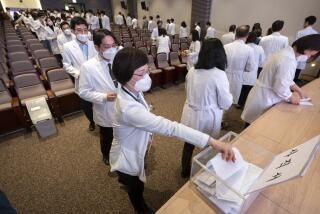Some Rest for Medical Residents
For generations, doctors in training have endured a grueling boot camp, often working in hospitals 100 or more hours a week -- at times becoming so overtaxed that they dozed off at the bedside of a patient or the wheel of a car.
Beginning Tuesday, the brutal apprenticeship of the nation’s medical residents will become more humane -- and, those who support the change said, safer for patients.
New rules will limit residents to an average workweek of 80 hours and to no more than 30 hours of work at a stretch. Though still a demanding schedule, double the typical worker’s week, the changes represent a cut of up to 40 hours a week in some specialties.
Besides reducing the potential for mistakes, the changes are intended to focus the training of young doctors less on labor and more on learning. The rules are being imposed by the group that accredits doctor training programs.
Many doctors said the change signals the demise of the macho era of medicine, worn as a badge of fortitude by some physicians and an emotional scar by others.
“It was torture,” recalled Dr. Sharon Ashley, an anesthesiologist and the director of graduate medical education at Martin Luther King Jr./Drew Medical Center, remembering her 15-month-old daughter nudging her awake as she drove home during her training. “We’re a kinder, gentler world.”
But residency directors worry that the new rules may promote a punch-the-clock mentality and cut too deeply into training time in specialties such as neurosurgery and orthopedics -- perhaps requiring doctors to spend another year practicing their techniques.
Doctors who wish to specialize in an area of medicine now spend up to seven years in training after getting their medical degrees.
The changes also deliver a blow to cash-starved public hospitals, especially in Los Angeles County, where the health department faces a crippling budget crisis. Hospitals won’t be able to rely as much on residents, who are relatively low-paid, to aid overburdened nurses, transport patients and draw blood. Instead, the facilities must spend millions on higher-paid staff to cover those duties.
Whether they support the changes or oppose them, many doctors consider them the most important shift in physician training in decades.
“This is a culture change,” said Dr. Lawrence Opas, director of graduate medical education at Los Angeles County-USC Medical Center, who noted that the term “resident” came into vogue because young doctors used to live and work at hospitals.
Medical educators said a variety of factors forced them to reassess doctor training, from changing notions of what it means to be a physician to pressure from the federal government and unions.
The new rules reflect evolving attitudes about work and family. Many of today’s medical residents are focused as much on the quality of their lives as their educations -- in part because of the increasing number of women in the programs, doctors said.
“People’s attitude about what being a doctor is all about ... has changed over time,” said Kristy Wolff, a third-year obstetrics-gynecology resident at County-USC and a residents union delegate. “The flexibility and the autonomy and the potential income from being a doctor has changed dramatically, so it has become more like a job -- and people don’t want to be working 110 hours at their job.”
Another impetus for change was the death in a hospital of Libby Zion, the 18-year-old daughter of a well-known New York newspaper columnist. He alleged that overworked residents were negligent. In 1989, the state cut residents’ hours to an average 80 hours a week after a grand jury, although finding no criminal fault on the part of doctors in the case, expressed concerns about overworked and under-supervised residents.
The national push for similar restrictions began a decade later, after an influential government advisory body, the Institute of Medicine, suggested that fatigue might cause medical errors. That year, the National Labor Relations Board gave residents permission to unionize, and their leaders made working conditions a top priority.
With a move afoot in Congress to restrict residents’ hours, the Accreditation Council for Graduate Medical Education, which regulates medical education, last June announced the rules that take effect Tuesday.
The change will be especially dramatic in certain specialties. In a 2001 survey at four of Los Angeles County’s public hospitals, neurosurgical and urology residents said they worked more than 120 hours per week in their first four years. Residents in pediatrics and obstetrics-gynecology reported working at least 90.
After completing medical school, doctors typically enroll in residency programs to gain in-depth experience in a particular specialty, such as neurology or surgery. During those programs, their work is overseen by a teaching physician. At the end, they take an exam to become certified in their specialties.
Dr. Martin Weiss, chairman of the neurosurgery department at County-USC, said the new work hours are going to hurt residents’ ability to acquire technical skills.
“You can’t operate on a patient at home,” he said. “A residency is an educational experience. It’s not a job.”
His department has requested a waiver that would allow it an average of eight more hours a week during certain periods. He and others worry that the new rules will instill a “shift mentality” among residents.
“We’re telling them that no matter what condition the patient is in that they must go home,” said Dr. Jay Lieberman, who supervises orthopedic residents at UCLA Medical Center.
Some doctors and residents said that, ironically, there may be more errors made when patients are handed off from resident to resident. They said that the doctor who admits the patient and orders the tests will probably know the nuances of the patient’s condition better than a newcomer.
Dr. Carol Berkowitz, acting director of graduate medical education at the county’s Harbor-UCLA Medical Center, said the programs need to guard against the sort of situation in which a resident, looking at his watch, says, “I’m sorry you have chest pain ... but I’m leaving.”
But Berkowitz, a pediatrician, said that staying at the hospital for days on end -- as she once did -- isn’t something she’d wish on today’s residents.
When she was pregnant in 1969, Berkowitz recalled, she was working full days at the hospital, then, every other night, staying at the hospital on call. Working 130 hours a week, she was on call the night before she delivered her child.
“I walked from my on-call room to the delivery suite,” she said. “The good news was that I kept falling asleep between contractions.”
Then, since she was the resident in the nursery, she went on rounds the next day. “You know what? I wouldn’t want my daughter to go through that.”
Studies are inconclusive on whether residents’ long hours affect performance. But sleep studies generally have shown that staying awake for 24 hours impairs judgment, alertness and coordination to the same degree as having a 0.1% blood-alcohol level, above the legal limit to drive a car in many states.
“Anyone’s performance is going to deteriorate, and doctors are not special people,” said Dr. Kingman Strohl, a professor of medicine at Case Western Reserve University and director of the Center for Sleep Disorders Research in Cleveland. “There’s ample data to show that ... being up for 36 hours impairs performance.”
Dr. David Thordarson, who heads the residency program for orthopedic surgery at County-USC, agreed, calling the new rules “100% appropriate”
Thordarson recalled that as a resident in the mid-1980s, he’d sometimes fall asleep in surgery or on the way home, though as far as he knows, he never harmed a patient.
After being at the hospital all night, Thordarson said, he’d review the charts the next day and not recall having given the orders that were written down. “The nurses are good enough where if you told them to do something outlandish, they wouldn’t do it. But as you can tell, the situation is ripe for errors.”
It will be tougher for public hospitals, especially in Los Angeles County, to rely less on residents, whose long hours of service they have come to depend on.
To meet the new standards, the county’s public hospitals, which help train about 1,642 residents each year, have had to restructure key programs, force residents to be on call more and cut vacation time.
The county also has had to come up with $7.4 million to hire support staff -- nurse practitioners, physicians’ assistants and clerks -- to complete the tasks residents now handle at Los Angeles County’s four full-service hospitals.
Hiring for the positions could take months, but because county supervisors approved the funding only last week, the county is at risk of violating the new rules from the outset.
“This is something that we wish could have been finalized well in advance,” said Dr. David Altman, chief medical officer of County-USC. “I frankly am worried a little bit by it.... There could be a period of time where things don’t get done or [teaching physicians] will have to fill in.”
The accreditation council, which oversees the training of about 100,000 residents in 7,800 programs, plans to check on the compliance of residency programs during annual visits. It can punish programs that violate its rules by putting programs on probation or potentially yanking accreditation, which means that the program could be shut down.
Ingrid Philibert, who supervises the hospital visits, said programs must show “substantial” compliance with the rules. “There is a point when telling us that you’ll be looking for a new faculty member is not enough,” she said.
Braden Hexom, legislative affairs director of the American Medical Student Assn., sees problems with the oversight plan.
“The only enforcement is loss of accreditation, and since that harms residents themselves, they don’t have a lot of incentive to report their programs,” he said.
More to Read
Sign up for Essential California
The most important California stories and recommendations in your inbox every morning.
You may occasionally receive promotional content from the Los Angeles Times.










